
WhatsApp / Feature Design
Feature 1
Eliminating confusion, establishing trust and increasing customer retention
Feature 2
Generating AI chat summaries for ease
Problem
How might we improve user experience in WhatsApp groups?
How might we improve user experience in WhatsApp groups?
Outcome
I developed two engaging features aorund WhatsApp groups and also organised the groups UI so that the app establises trust and is more user-friendly.
I developed two engaging features aorund WhatsApp groups and also organised the groups UI so that the app establises trust and is more user-friendly.
Role
UI UX designer
UI UX designer
Team
Solo Project
Solo Project
Timeline
3 Weeks
3 Weeks
Software
Figma
Figma

Context
Being hugely popular, I studied WhatsApp in detail.
What I found:
Being hugely popular, I studied WhatsApp in detail.
What I found:
- People get added to WhatsApp Groups with consent seems to be a huge issue if 2 billion people use it on the daily.
- There are various ways WhatsApp can leverage AI to make the whole user experience more effortless.
Impact
In 2024, WhatsApp introduced a significant update to organising chats through filters.
Notably, this update coincided with the design of this project in 2024, which included similar group management features. The alignment between this design and WhatsApp's subsequent update underscores the relevance and foresight of my approach to enhancing group functionalities.
New WhatsApp Features
01
02
Generate AI Chat Summary
01
Invitation to join a WhatsApp Group
02
Generate AI Chat Summary

PROCESS
01
Research & Discovery
Research & Discovery

02
Competitor Analysis
Telegram, Signal and iMessage are some relevant competitors. Each has a distinct features from the other. Below is an analysis of their positioning and their unique features.
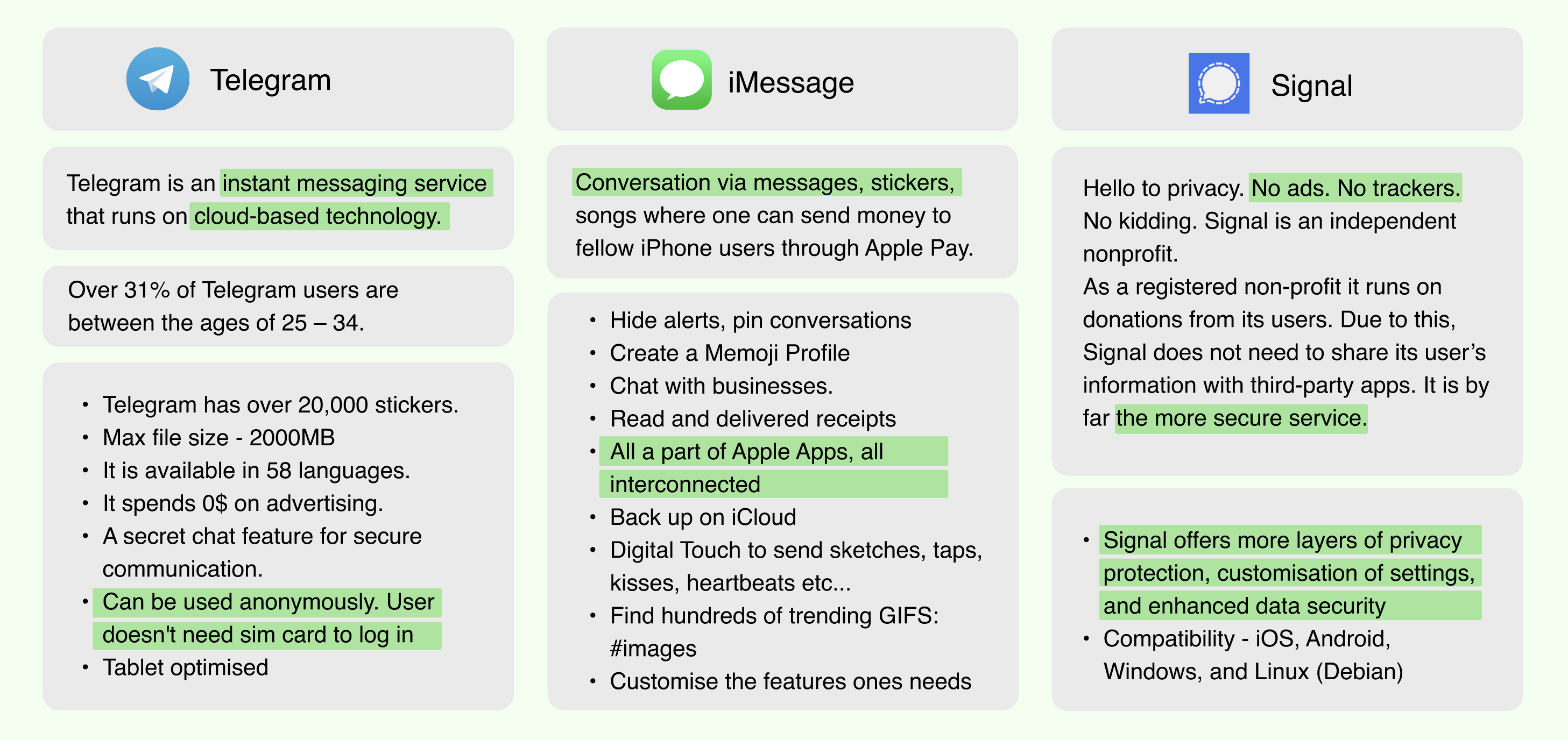
03
User Interviews
After desk research, I found four users with varying degrees of WhatsApp experience. I interviewed them with a list of questions on their usage of WhatsApp, their favourite features along any pain points experienced while using the app.
Interestingly, all users mentioned their frustrations with the groups and communities feature.
User Interviews
After desk research, I found four users with varying degrees of WhatsApp experience. I interviewed them with a list of questions on their usage of WhatsApp, their favourite features along any pain points experienced while using the app.
Interestingly, all users mentioned their frustrations with the groups and communities feature.

04Synthesis & Prototypes
Synthesis & Prototypes
After gathering all my findings and research, I synthesised all this data and created a few main pain points to tackle for this project.
Insight #1
It is hard to find chats
The current app lays out all chats in the homepage, be it direct chats or groups. Sometimes, users can forget the group name or even forget that they are a part of a particular group. This can annoy users since the groups’ feature is fully optimised.
User Testing
I tested a lot of prototypes with 6 users who used the app on a daily basis. This helped me get better insights.
The users reacted well to organising the groups concept however, they didn’t think it should be a part of the communities feature. Thus, I worked on organising the app via direct and group chats.
Prototypes for organising the group chat feature
Solution #1
Organise group chats feature
This solution was straightforward. I researched other apps such as Slack and Spotify to see the way they categorise their content. I sketched ideas on creating a solution where the homescreen still had both firect and group chats but there is now a option underneath the heading namely, “Direct” and “Group”.
The group chats are further divided in custom group categories, with titles that are presuggested or given by its user.
The groups can be saved under these categories. Existing groups can be added by going into their settings/admin page. While, new groups add the category they belong to upon creation.
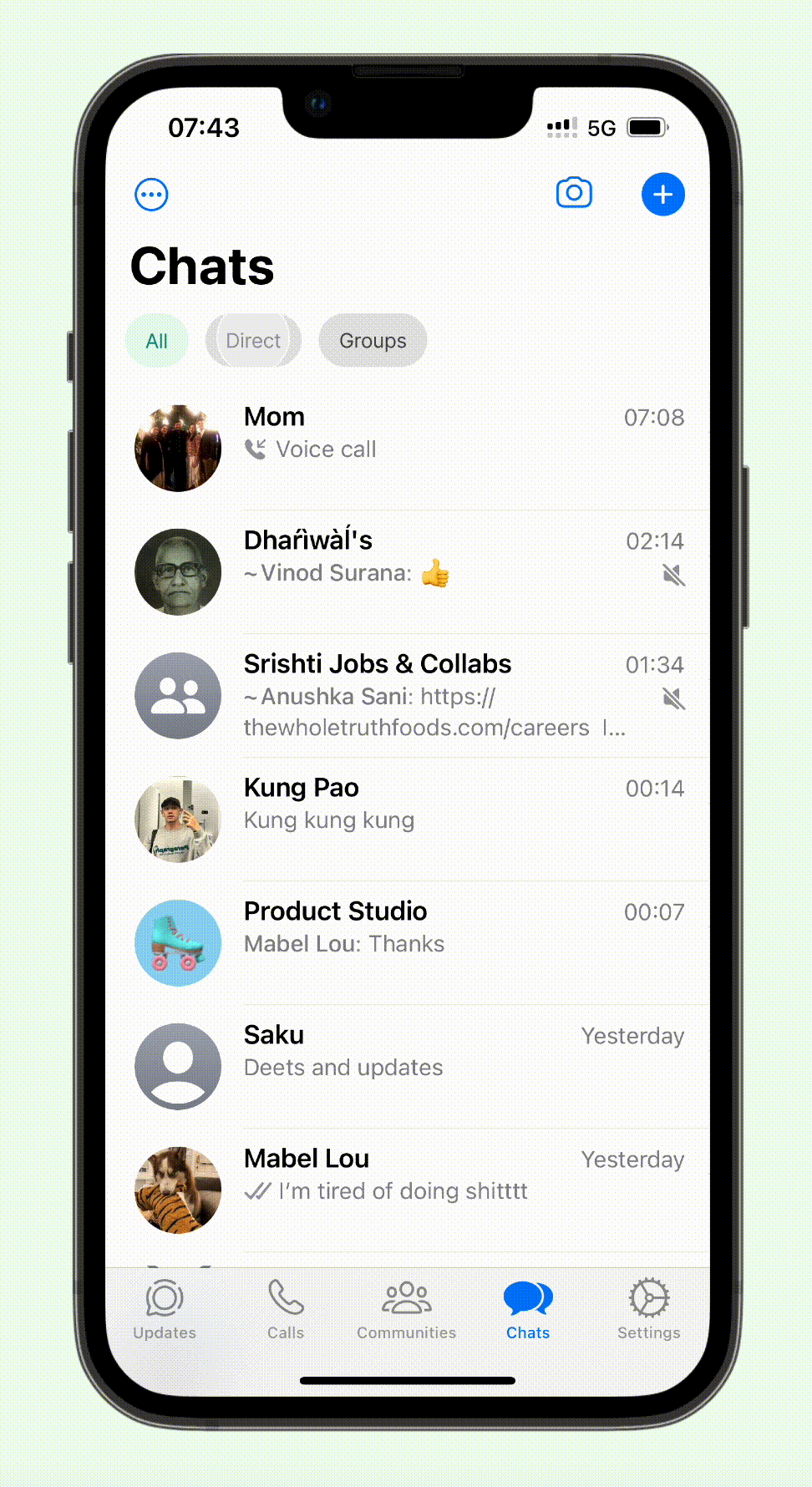

User Testing #1
Upon testing this idea with 5 users, it was very well received and users felt that this feature already should have been incorporated way back.

Insight #2
Being added to a WhatsApp group without consent is frustrating
Users feel a sense of distrust and irritation when they are added into groups without their consent. It causes unwanted messages and sometimes spam by resellers or brands. This arises the need to block that often suggests an unfriendly feeling.
User Testing
Upon testing this idea with users, 100% of the users felt that the invite was absolutely necessary and would want it on the app.
They were resistent to adding the group description but liked the idea of categorising it. However, they also wanted an option to categorise it in the group chats window.
Prototypes for an invite feature for potential group participants
![]()
![]()
![]()
![]()

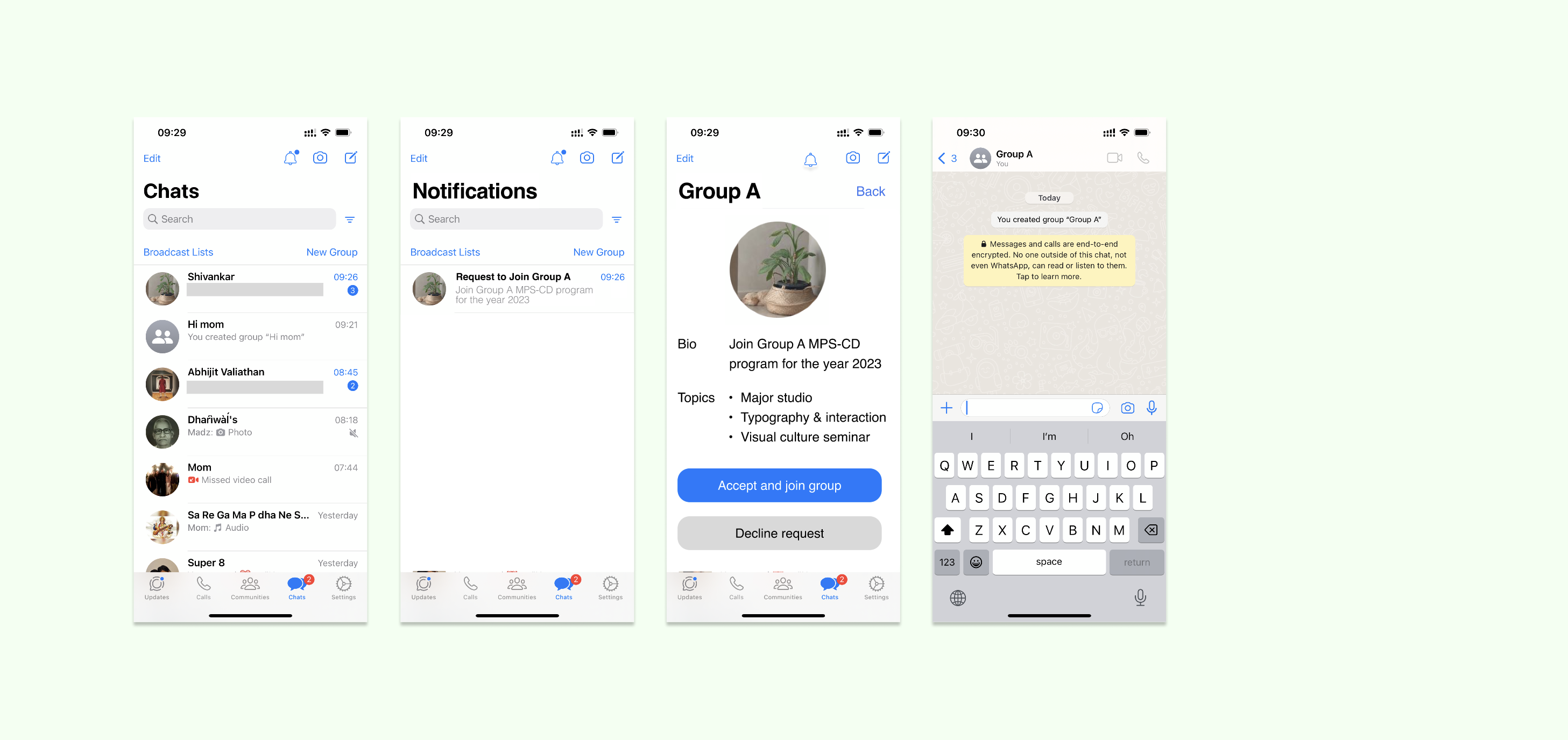


Solution #2
An “invite” button for adding potential group participants
This solution was also straightforward and surprising since giving and receiving consent is a basic need. Thus, for this solution I decided to keep the same flow of creating a new group and introducting new information additions when filling in group details.
Thus, after the group admin names the group, there is an option to choose a relevant category for it. This saves it on their WhatsApp. Another addition is to add a description which draws attention through a bubble that states “Inform all members what the group is about”. However, this is not mandatory since there are various scenarios.
After filling in the details, the admin clicks on “invite” which automatically sends an invite to the potential participants they chose in the steps before.
The next page is a confirmation of the invitation.
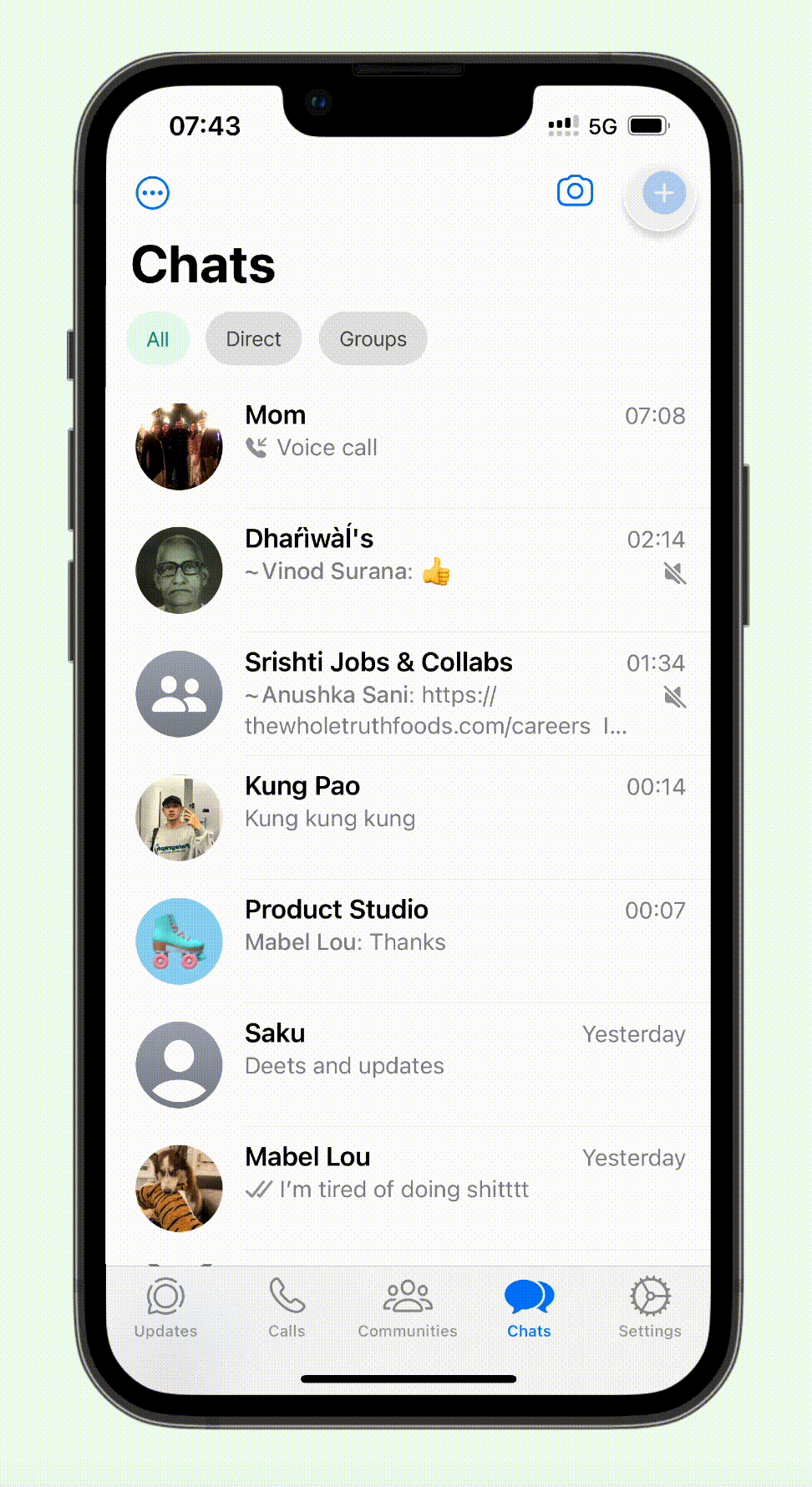

Insight #3
It is a pain when you are in a group and miss several messages, then have to go back and read them all
Being a part of active groups with a lot of participants causes one to miss a few too many messages when away from the phone while a conversation is ongoing. Sometimes the conversations can result is 100 of missed messages. This can be a pain to catch up with.
Prototype: UI designs for generate Ai chat summary
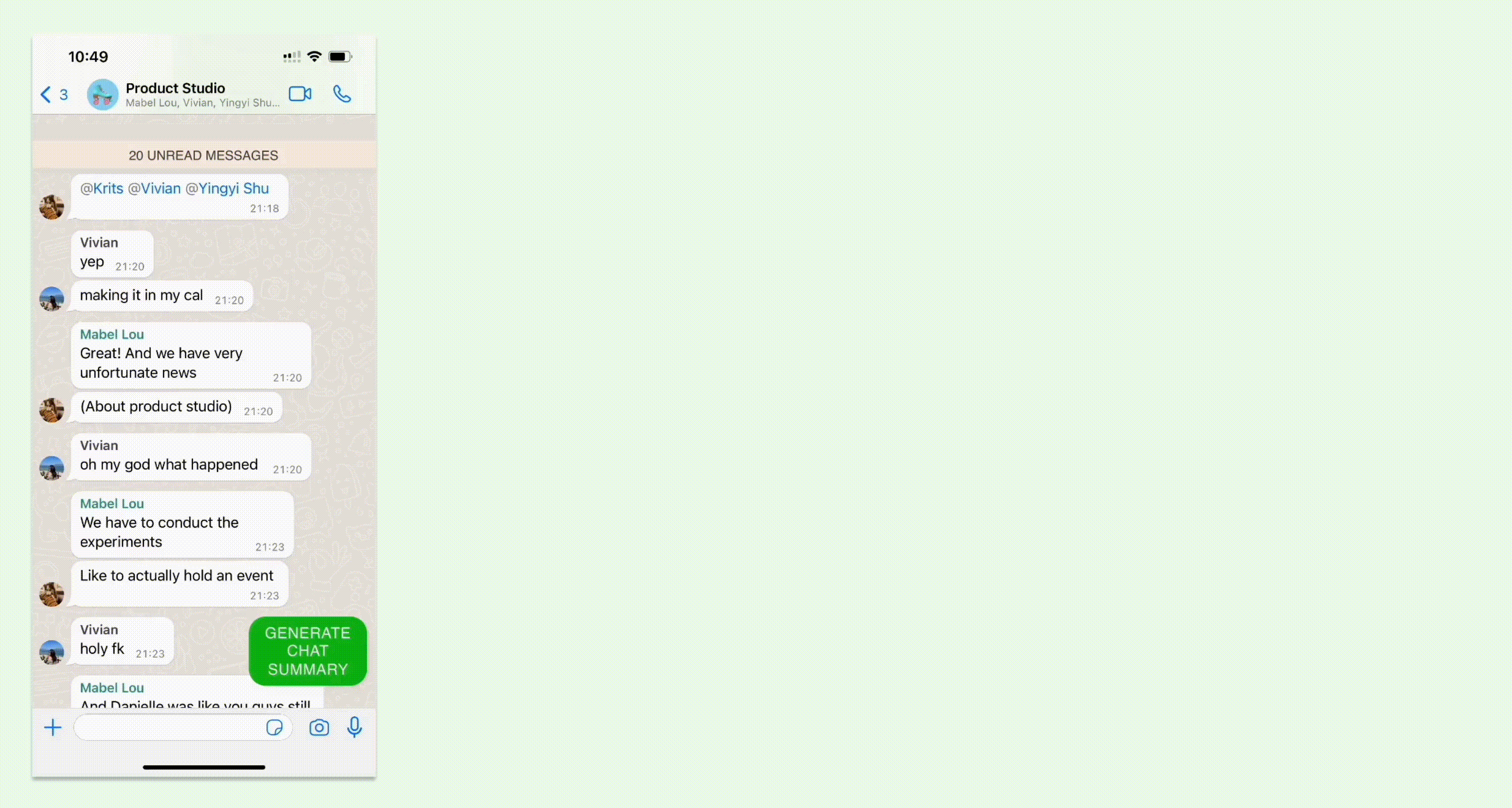
User Testing #3
The users were most thrilled about this feature, it created a sense of excitement and curiosity of how it would work. At the same time, there were users who were very apprehensive about sharing information with Ai. They were also curious about the accuacy of the chat. While they felt it would help with more personal groups, since there are less stakes involved but they wanted to be sure that the summary was accurate.
They also wanted to be able to provide feedback on the summary in case of inaccuracy so that this feature could be made “perfect” and they would love to use it.


Solution #3
An Ai generated chat summary
With the advent of machine learning models such as Ai, this solution felt a little out of the box yet in the realm of what is being developed.
When a user missed a set number of messages (they can set via settings), the WhatsApp Ai Bot would show an option underneath the “Unread Messages” count stating “Tap to generate summary”.
If the user chooses to use this option, the Bot produces a summary consisting of all unread messages at the end of the window after the chats in a matter of seconds.
There is an arrow next to the summary window in case the user wants to go up and check the chat. (Added after user testing).


Reflection
This was one of my first UX UI projects. Exploring an existing App in detail helped me understand the myriad features a successful app offers. It has to consider various stakeholders and their needs along with several scenarios in which they engage with the App while also introducing features that they never thought of but made life easy.
I was happy with the solutions and user testing gave me confidence and clarity. On the whole, this was a great learning curve in terms of UX flows, adding minute details to make them better and also when introducing a brand-new feature to the App.
I was happy with the solutions and user testing gave me confidence and clarity. On the whole, this was a great learning curve in terms of UX flows, adding minute details to make them better and also when introducing a brand-new feature to the App.